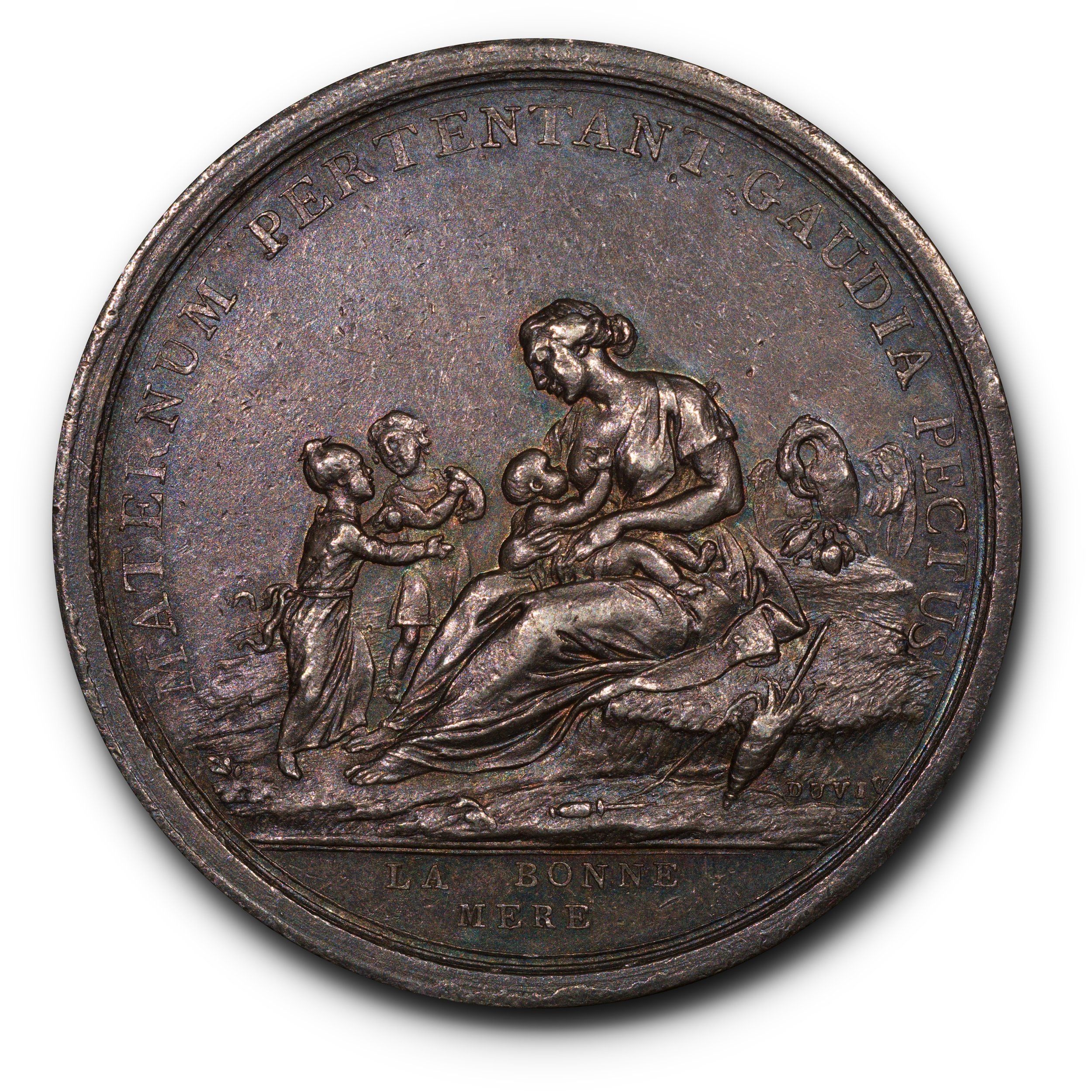C. 1800 France Normandie (Canon, Vieux-fumé, et Mézidon) Silver Medal Mule, VF.
41.5mm. 31.0 grams. Admittedly, these kinds of French medals are not typically something I would handle, but the iconography on this piece and the lovely patina are impossible to resist.
The obverse matches that of Feuardant-6382, part of a series for the towns of Canon, Vieux-Fumé, and Mézidon in the Normandie region of France, while the reverse was used to commemorate the second marriage of the Dauphin and Maria-Josepha of Saxony on February 9, 1747.
The obverse features a seated mother breast-feeding a baby with two children to her left. Behind her sits a pelican, feeding its young. Signed at right by the famed French medalist Jean Duvivier, the artist responsible for, among other important works, the Libertas Americana medal. The legend above reads MATERNUM PERTENTANT GAUDIA PECTUS, roughly translated as “they fill their mothers’ hearts with joy.” LA BONNE MERE, “the good mother,” appears in the exergue.
The reverse features Hymenaeus lighting her torch with the sacred fire burning on an altar. In front of him stands a female figure, with Cupid above carrying a shield with the arms of Saxony. The legend around reads COMMUNE PERENNITATIS VOTUM, the universal wish for the duration of the Royal House, with SECUNDAE DELPHINI NUPTAE / MDCCXLVII (1747) in the exergue.
The medal has elegant patina with rich coloration, sharp squared-off rims, and minimal cabinet friction. A large die break occurs at the lower left reverse.
41.5mm. 31.0 grams. Admittedly, these kinds of French medals are not typically something I would handle, but the iconography on this piece and the lovely patina are impossible to resist.
The obverse matches that of Feuardant-6382, part of a series for the towns of Canon, Vieux-Fumé, and Mézidon in the Normandie region of France, while the reverse was used to commemorate the second marriage of the Dauphin and Maria-Josepha of Saxony on February 9, 1747.
The obverse features a seated mother breast-feeding a baby with two children to her left. Behind her sits a pelican, feeding its young. Signed at right by the famed French medalist Jean Duvivier, the artist responsible for, among other important works, the Libertas Americana medal. The legend above reads MATERNUM PERTENTANT GAUDIA PECTUS, roughly translated as “they fill their mothers’ hearts with joy.” LA BONNE MERE, “the good mother,” appears in the exergue.
The reverse features Hymenaeus lighting her torch with the sacred fire burning on an altar. In front of him stands a female figure, with Cupid above carrying a shield with the arms of Saxony. The legend around reads COMMUNE PERENNITATIS VOTUM, the universal wish for the duration of the Royal House, with SECUNDAE DELPHINI NUPTAE / MDCCXLVII (1747) in the exergue.
The medal has elegant patina with rich coloration, sharp squared-off rims, and minimal cabinet friction. A large die break occurs at the lower left reverse.
41.5mm. 31.0 grams. Admittedly, these kinds of French medals are not typically something I would handle, but the iconography on this piece and the lovely patina are impossible to resist.
The obverse matches that of Feuardant-6382, part of a series for the towns of Canon, Vieux-Fumé, and Mézidon in the Normandie region of France, while the reverse was used to commemorate the second marriage of the Dauphin and Maria-Josepha of Saxony on February 9, 1747.
The obverse features a seated mother breast-feeding a baby with two children to her left. Behind her sits a pelican, feeding its young. Signed at right by the famed French medalist Jean Duvivier, the artist responsible for, among other important works, the Libertas Americana medal. The legend above reads MATERNUM PERTENTANT GAUDIA PECTUS, roughly translated as “they fill their mothers’ hearts with joy.” LA BONNE MERE, “the good mother,” appears in the exergue.
The reverse features Hymenaeus lighting her torch with the sacred fire burning on an altar. In front of him stands a female figure, with Cupid above carrying a shield with the arms of Saxony. The legend around reads COMMUNE PERENNITATIS VOTUM, the universal wish for the duration of the Royal House, with SECUNDAE DELPHINI NUPTAE / MDCCXLVII (1747) in the exergue.
The medal has elegant patina with rich coloration, sharp squared-off rims, and minimal cabinet friction. A large die break occurs at the lower left reverse.

